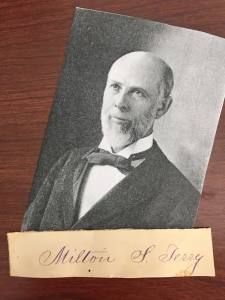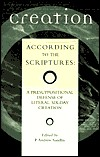INTRODUCING MILTON TERRY (2)
 PMW 2021-022 by Kenneth L. Gentry, Jr.
PMW 2021-022 by Kenneth L. Gentry, Jr.
This is the second in a two-part series introducing the life and ministry of Milton S. Terry. Terry was a scholarly advocate of both postmillennialism and preterism. Though I do not agree with all of his positions (even utterly rejecting some of them), his scholarly insights into Revelation are for the most part extremely helpful.
So let us continue, now by presenting his:
Published Writings
Terry was not only an accomplished scholar and an effective instructor, but he was also a prolific writer. He wrote extensively on apologetics, philosophy, comparative religions, and dogmatics. He wrote many articles for a variety of publications, including the Methodist Quarterly Review, The Old Testament Student, Sunday School Times, The Northwestern Christian Advocate, and others.
He is best remembered today, however, for his books, several of which are still in print. He wrote more than thirty books, among which are:
The Bible and Other Sacred Books : a Contribution to the Study of Apologetics and Comparative Theology (1890)
Biblical Apocalyptics: A Study of the Most Notable Revelations of God and of Christ in the Canonical Scriptures (1898)
Biblical Dogmatics: An Exposition of the Principal Doctrines of the Holy Scriptures (1907)
Biblical Hermeneutics: A Treatise on the Interpretation of the Old and New Testaments (1883)
Chronicles and the Mosaic Legislation (1888)
Commentaries on the Historical Books of the Old Testament (2 vols. 1873–75).
The Experience according to the Scriptures (1902)
Genesis and Exodus (1889)
Jesus Christ on Marriage and Divorce (1910)
Man’s Antiquity and Language (1881)
The Mediation of Jesus Christ: A Contribution to the Study of Biblical Dogmatics (1903)
Moses and the Prophets: An Essay toward a Fair and Useful Statement of Some of the Positions of Modern Biblical Criticism (1901)
The New and Living Way: An Orderly Arrangement and Exposition of the Doctrines of Christian Experience, according to the Scriptures (1902)
The New Apologetic: Five Lectures on True and False Methods of Meeting Modern Philosophical and Critical Attacks Upon the Christian Religion (1897)
Philosophical and Critical Attacks upon the Christian Religion (1897)
Primer on Christian Doctrine: In the Form of Questions and Answers (1906)
The Prophecies of Daniel Expounded (1893)
Rambles in the Old World (1894)
The Shinto Cult: A Christian Study of the Ancient Religion of Japan (1910)
The Sibylline Oracles Translated from the Greek into English Blank Verse (1899)
His most influential work in evangelical circles was his magisterial Biblical Hermeneutics (511 pages; 1883). This has been highly regarded by many scholars and even used in various evangelical colleges and seminaries over the years. Masters’ Seminary professor Robert L. Thomas notes that Biblical Hermeneutics “was viewed as the standard work on biblical hermeneutics for most of the twentieth century.” [1] Thomas goes on to state that Terry’s “basic principles of hermeneutics make the most sense” (p. 12). Terry’s classic work is still in print today.
 Creation according to the Scriptures
Creation according to the Scriptures
Ed. by P. Andrew Sandlin
This book is sub-titled: A Presuppositional Defense of Literal , Six-day Creation. It has chapters by R. J. Rushdoony, Andrew Sandlin, Kenneth Gentry, Cornelius Van Til, and others. It touches on historical, exegetical, theological, and philosophical implications of Six-day Creation.
See more study materials at: www.KennethGentry.com
The book that you are currently reading was lifted from Terry’s Biblical Apocalyptics, which was a large work of 512 pages. Biblical Apocalyptics, which is also still in print, was one volume of a three volume set. The first volume in this set was Biblical Hermeneutics (1883), which presented interpretive principles that are so important for his study Revelation, which you have before you in this special volume.
Biblical Apocalyptics was his second volume in this series (1898). Terry explains on p. 8 of that work: “The present treatise is the second in my plan, and, in nature and scope, is supplementary to the Hermeneutics, being an extended application and illustration of the principles of interpretation set forth therein.” The material contained in the present book that you have in your hands consumed half of the number of pages in its original source.
The third volume in the set was Biblical Dogmatics (604 pages; 1907). His goal in that volume was stated in advance in Biblical Apocalyptics as being “an essay toward a luminous, simple and systematic statement of the principal doctrines of the Old and New Testaments” (p. 8). Then in Biblical Dogmatics itself he stated that it is a “systematic exposition of religious truth” ( p. vi). Thus, he noted, “with [this] publication we complete the trilogy of our contributions to the study of biblical interpretation and doctrine which we began in 1883” (p. viii).
Death and Burial
In February 1914 Terry began an extended sabbatical during the second semester of the school year to gain some much needed rest from his many labors. He went with his wife to Los Angeles, California where he had many friends from among his former students and colleagues.
The Early Date of Revelation and the End Times: An Amillennial Partial Preterist Perspective
By Robert Hillegonds
This book presents a strong, contemporary case in support of the early dating of Revelation. He builds on Before Jerusalem Fell and brings additional arguments to bear.
See more study materials at: www.KennethGentry.com
On Sunday July 12, 1914 he preached at the Methodist Episcopal Church in the city of Covina, which is near Los Angeles. Later that afternoon he suddenly became quite ill. The next morning, July 13, he had a heart attack and died at the age of 74. Just two months before this (May 15), he and his wife had celebrated their fiftieth anniversary. [2]
His wife escorted his body back to Illinois. His funeral was held at Rose Hill Cemetery Chapel in Chicago, on Sunday, July 19, 1914. Rev. Dr. Charles M. Stuart, president of Garrett Biblical Institute conducted the service.
But “though he is dead, he still speaks” (Heb. 11:4) through his many published writings, which have gone in and out of print over the last century.
Notes
1. Robert L. Thomas, “The Principle of Single Meaning,” Master’s Seminary Journal (Spring 2001): 5 n1.
2. “Death of Dr. Milton S. Terry,” The Christian Advocate (July 23, 1914), 22.
Kenneth L. Gentry Jr.'s Blog
- Kenneth L. Gentry Jr.'s profile
- 85 followers



